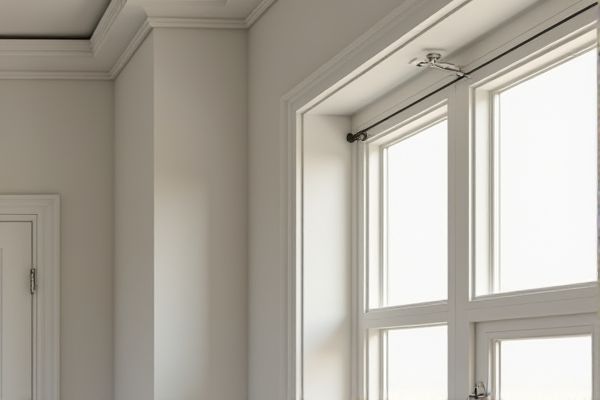
Corner rods maximize closet space by fitting neatly into corners, while straight rods provide a traditional, linear hanging solution ideal for longer garments. Discover which option best suits your storage needs and enhances Your closet organization in the following article.
Table of Comparison
| Feature | Corner Rod | Straight Rod |
|---|---|---|
| Design | Angled to fit corners, typically 90 degrees | Linear, straight bar without bends |
| Installation | Requires corner mounting, often more complex | Easy to install on flat walls |
| Space Utilization | Maximizes corner space efficiently | Best for wide, unobstructed wall areas |
| Applications | Ideal for corner showers, closets, or rooms | Suitable for traditional shower setups or curtain hanging |
| Stability | Strong support at two wall points | Supports between two fixed points on one wall |
| Visual Impact | Blends with corner for seamless look | Visible straight line that defines space |
| Price | Generally higher due to design complexity | Usually more affordable and standard |
Introduction to Corner Rods and Straight Rods
Corner rods and straight rods are essential components in curtain rod systems, designed to fit specific window or room configurations. Corner rods are tailored to navigate 90-degree angles, providing seamless curtain transitions around room corners without gaps. Straight rods offer simplicity and versatility for standard flat window frames or walls, supporting various curtain styles for straightforward installations.
Key Differences Between Corner and Straight Rods
Corner rods are specifically designed to fit into angled spaces, typically at 90-degree corners, maximizing the efficient use of room without requiring additional hardware. Straight rods, on the other hand, are linear and ideal for open wall spaces, offering easier installation and adjustment with standard brackets. The key difference lies in their shape and application: corner rods optimize corner spaces, while straight rods provide straightforward support across flat surfaces.
Design and Aesthetic Considerations
Corner rods maximize space efficiency by fitting snugly into room angles, offering a seamless, integrated look that enhances modern interiors. Straight rods provide versatile installation options with a classic, streamlined appearance suitable for minimalist and traditional decor. Material choices and finishes further influence the visual impact, with metallic or matte textures complementing various design themes.
Space Efficiency and Room Layouts
Corner rods maximize space efficiency by utilizing underused corner areas, making them ideal for small or irregularly shaped rooms. Straight rods work best in standard room layouts, offering a simple installation along flat walls but often occupying more linear wall space. Choosing corner rods enhances storage capacity without disrupting room flow, whereas straight rods suit open layouts with ample wall space.
Installation Process: Corner vs Straight Rods
Corner rods require precise angle measurements and mounting on two adjacent walls, making installation more complex compared to straight rods that typically involve straightforward mounting on parallel surfaces. Straight rod installation usually involves aligning brackets at standard intervals and securing them with screws, which is quicker and more accessible for DIY projects. Corner rods often need specialized hardware and tools due to their L-shaped design, increasing installation time and effort.
Durability and Material Options
Corner rods and straight rods vary significantly in durability and material options, with corner rods often crafted from reinforced metal alloys or heavy-duty plastics to withstand angular stress and improve longevity. Straight rods typically offer a wider range of material choices such as stainless steel, aluminum, and fiberglass, which contribute to their resistance against corrosion and wear in linear applications. Both rod types provide durable solutions, but corner rods are specialized for durability at joint angles, while straight rods excel in flexibility of materials for various environmental conditions.
Cost Comparison: Corner Rods vs Straight Rods
Corner rods generally cost more than straight rods due to their specialized design and additional materials required for angled construction. Straight rods are typically more affordable, benefiting from simpler manufacturing processes and widespread availability. When budgeting for curtain hardware, the price difference between corner rods and straight rods can influence project decisions, especially for custom installations.
Best Use Cases for Corner Rods
Corner rods excel in maximizing closet space by fitting seamlessly into corners, making them ideal for small or irregularly shaped rooms. Their design allows for efficient storage of longer garments such as coats and dresses without wasting space in narrow areas. Using corner rods enhances organization by providing a dedicated area for hanging clothes while keeping the closet layout more accessible and clutter-free.
Best Use Cases for Straight Rods
Straight rods are ideal for long, expansive window treatments, providing a clean and minimalist look that enhances your room's lines. They work best in areas where curtains need to slide easily across a wide span, such as living rooms or bedrooms with large windows or sliding doors. Your choice of straight rods supports functionality and style, especially in modern or contemporary interior designs.
Choosing the Right Rod for Your Space
Selecting the right rod depends on your room's layout and functional needs, with corner rods ideal for maximizing space in awkward or compact corners. Straight rods work best for straightforward window treatments, offering a clean, classic appearance and ease of installation on flat walls. Consider the dimensions of your window and adjacent walls to determine whether a flexible corner rod or a rigid straight rod will provide optimal coverage and aesthetic appeal.
 homyna.com
homyna.com